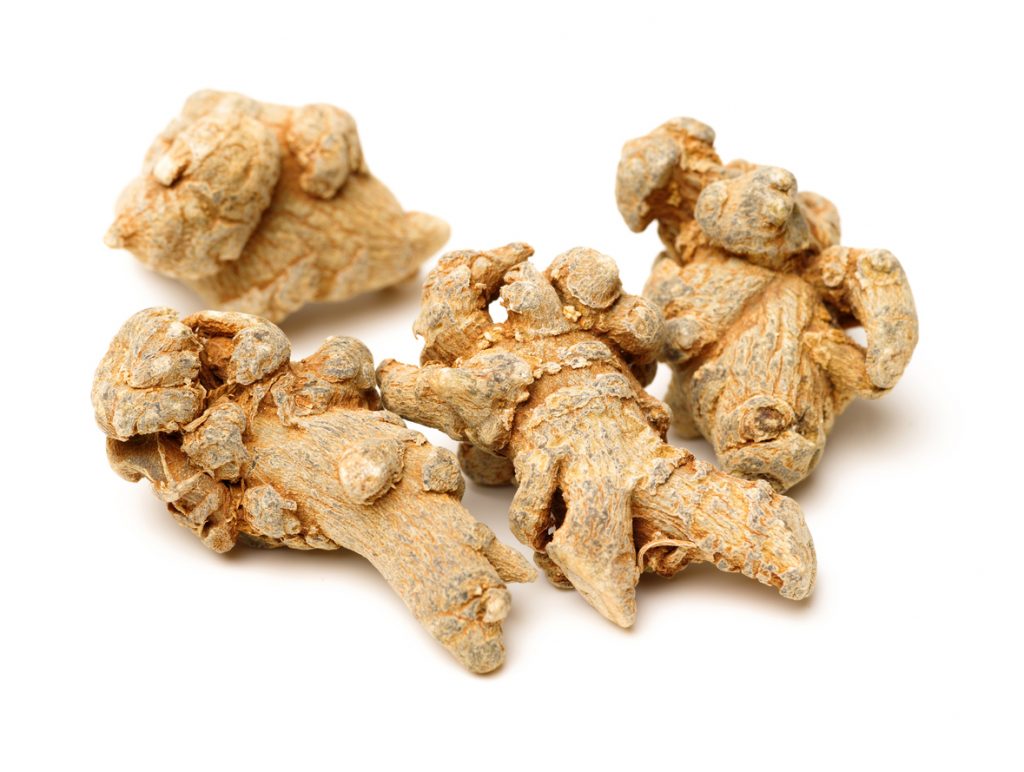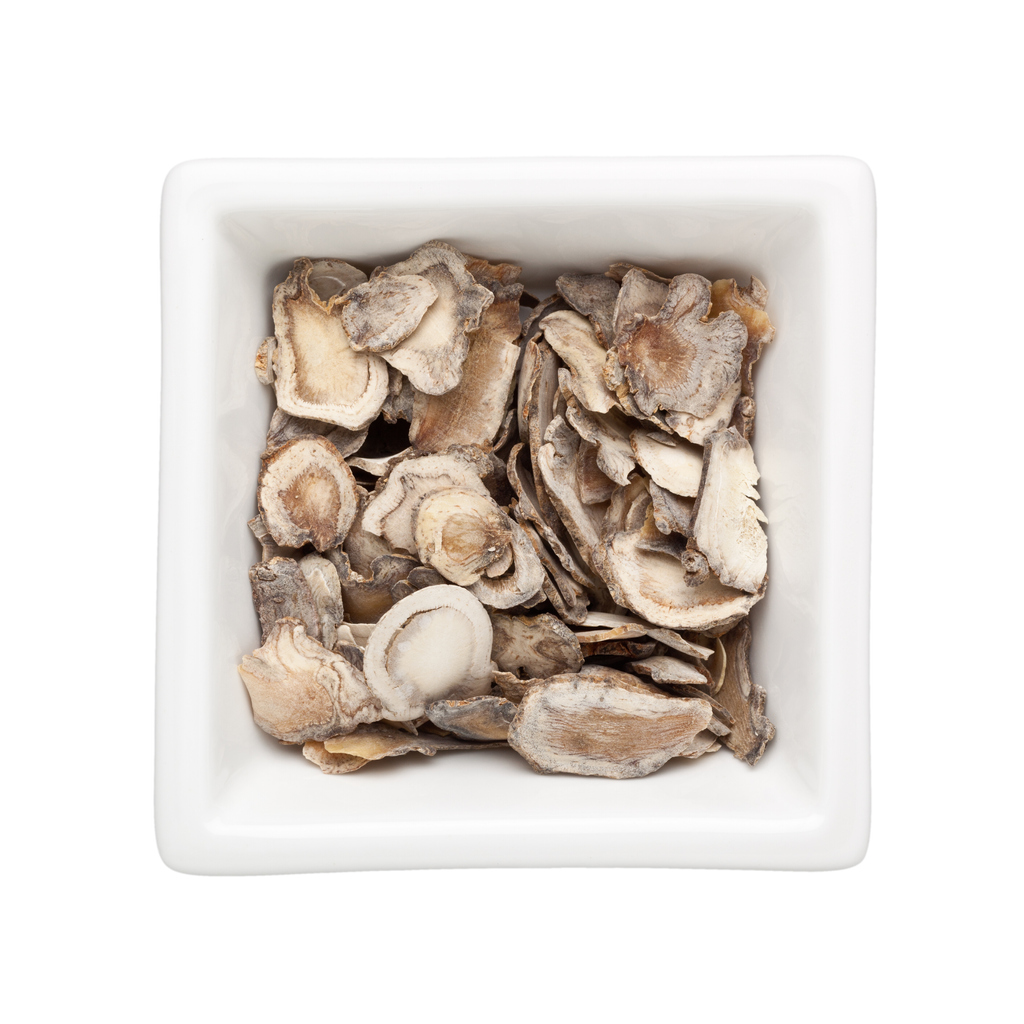Sanchi (Panax Notoginseng)

What is Sanchi (Panax Notoginseng)?
Sanchi (san qi, 三七), also known as Panax Notoginseng or Pseudoginseng, is a precious Chinese herb that has been used for more than 3000 years. Answering the long-time debate of Notoginseng vs Ginseng, the Compendium of Materia Medica stated that while Ginseng is the best to replenish qi, Panax Notoginseng is the best to nourish blood. Therefore, Both Ginseng and Panax Notoginseng are the most precious of Chinese herbs.
Its Chinese name san qi, which means ‘three seven’, is derived from the fact that it is the roots of a plant that has three lead stalks with seven leaflets each. This plant can reach a height of approximately four feet, and is usually harvested between three to seven years after planting. The roots are dug out either in the spring or winter, and the former is believed to be of better quality than the latter. After cleaning, the Notoginseng root is then dried in the sun and sliced.
In Traditional Chinese Medicine (TCM), Panax Notoginseng belongs to the category of ‘Herbs that stop bleeding’. This herb has hemostatic properties, which mean that it can help to stop various types of hemorrhages and ecchymosis. Warm in nature, Panax Notoginseng also helps to restore the yin-yang balance in individuals who have too much Cold in their body, such as individuals who are experiencing Yin Excess or Yang Deficiency.
Bitter and sweet in taste, Panax Notoginseng tends to have a cleansing action on the body by clearing Heat, drying Dampness and promoting elimination via urination or bowel movements. It can also slow down acute reactions, detoxify the body, and tonify the body by replenishing qi and blood. In particular, Panax Notoginseng targets the Stomach and the Liver.
Functions and Benefits of Panax Notoginseng

Traditional Chinese Medicine (TCM) shows that Panax Notoginseng has the following benefits.
Panax Notoginseng helps to stop bleeding. This herb can stop bleeding without retaining Blood Stasis, and resolve it without impairing healthy qi. Also, it can promote the generation of new tissue. Therefore, it is often used for different kinds of interior and exterior bleeding with or without Stasis, especially the former. Due to its ability to stop excessive bleeding and clear lochia (post-natal discharge), this herb is also beneficial for women who have just given birth.
Panax Notoginseng can reduce inflammation, swelling and associated pain. This herb can dilate blood vessels, promote blood circulation and resolve blood stasis to alleviate pain and eliminate swelling. Hence, it is an excellent choice for various syndromes of blood stasis and a key herb for trauma such as traumatic injuries, fracture, as well as damage of tendon and bone. When combined with blood and qi–moving herbs, Panax Notoginseng can also help with symptoms such as carbuncle and abscess.
Other than the above Panax Notoginseng benefits, modern research has also found that Panax Notoginseng can protect our cardiovascular and cerebrovascular system, as well as boost heart health. It can prevent diseases such as arrhythmia, myocardial ischemia and myocardial infarction. The herb can also help to protect brain cells after acute cerebral ischemia and hypoxia. Studies have also suggested that Panax Notiginseng may help to regulate blood sugar levels, lower cholesterol, improve heart functions and reduce chest pain caused by coronary heart disease.
As Panax Notoginseng can also inhibit the central nervous system, it can soothe the nerves, manage anxiety, improve sleep quality, and treat dizziness and tinnitus.
Also, this herb can inhibit tumor-growth, protect the liver from chemical damage such as alcohol, promote the growth of liver cells, slow down the ageing process and strengthen your immune system. Some parents also use this herb to promote the development of their children during puberty. Its ability to enhance blood circulation and prevent Blood Stasis is said to improve the flow of nutrients to the child’s bones and around his or her body.
How to Use Panax Notoginseng

Because of its hard texture, Panax Notoginseng is usually grounded as powder for easy consumption. Also, the human body can absorb the active substances of Panax Notoginseng more effectively when the herb is in the form of powder.
Panax Notoginseng powder can be eaten raw or cooked in many different ways. For example, some take the powder singly, or take it with yellow rice-wine or water. The typical dosage of Panax Notoginseng is between 3 and 10 grams of sliced, dried root, ground into powder.
Panax Notoginseng powder can also be used externally. For example, it can be sprinkled on broken skin to heal it quickly.
Cautions and Side Effects of Panax Notoginseng
Some potential side effects of using Panax Notoginseng include dry mouth, flushed skin, rash, headache and vomiting.
Also, certain groups of individuals should avoid using Panax Notoginseng. Firstly, pregnant women and menstruating women should not consume this herb. Secondly, children should avoid using this herb too. Last but not least, individuals who are experiencing Blood Deficiency or Yin Deficiency should also avoid this herb.
Generally speaking, one should not take more than ten grams of Panax Notoginseng powder for oral administration per day, and no more than three grams at a time.
Summary
Here is a summary for Panax Notoginseng:
- Herb name (Chinese): 三七
- Herb name (Pin Yin): sān qī
- Herb name (English): Sanchi
- Herb name (Botanical): Radix et Rhizoma Notoginseng
- Origin of species: Panax notoginseng (Burk.) F. H. Chen
- Part(s) of herb used: Root and rhizome
- Geo-specific habitat(s): Yunnan, Guangxi
- Taste(s) & Properties: Sweet, slightly bitter; Warm; Administrates the Liver and Stomach meridians
- Actions: Relieves bleeding symptoms; Aids recovery process resulting from internal or external injuries by relieving swelling and pain; Nourish and tonify the body.
References
Ng, T. B. (2006). Pharmacological activity of sanchi ginseng (Panax notoginseng). Journal of Pharmacy and Pharmacology, 58(8), 1007-1019. [Accessed on 20 September 2022]
Yang, X., Xiong, X., Wang, H., & Wang, J. (2014). Protective effects of panax notoginseng saponins on cardiovascular diseases: a comprehensive overview of experimental studies. Evidence-Based Complementary and Alternative Medicine, 2014.[Accessed on 20 September 2022]
Zhao, G. R., Xiang, Z. J., Ye, T. X., Yuan, Y. J., & Guo, Z. X. (2006). Antioxidant activities of Salvia miltiorrhiza and Panax notoginseng. Food chemistry, 99(4), 767-774.[Accessed on 20 September 2022]
Zhou, N., Tang, Y., Keep, R. F., Ma, X., & Xiang, J. (2014). Antioxidative effects of Panax notoginseng saponins in brain cells. Phytomedicine, 21(10), 1189-1195.[Accessed on 20 September 2022]
Share this article on
